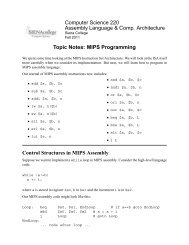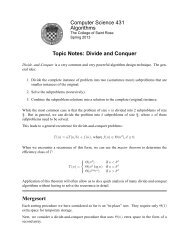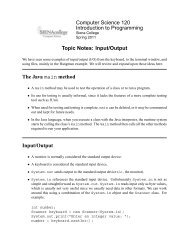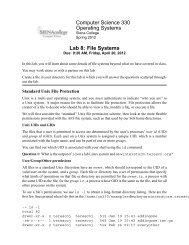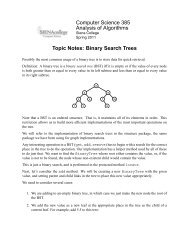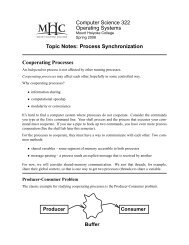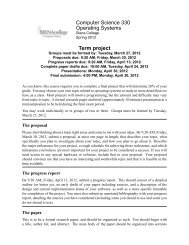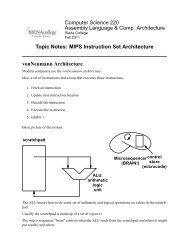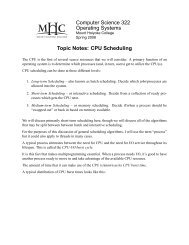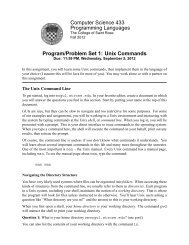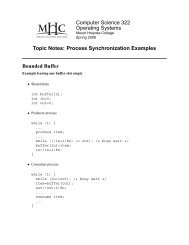You also want an ePaper? Increase the reach of your titles
YUMPU automatically turns print PDFs into web optimized ePapers that Google loves.
164 вычислительные методы и программирование. 2011. Т. 12координаты (0.6, 0.19); контрольная точка, в которой производилось сравнение перемещений, расположенана правом конце балки и по середине ее высоты — координаты (0.6, 0.2). Поле модуля и смещение балкипредставлены на рис. 4б.Всего рассматривалось два стационарныхварианта: при числах РейнольдсаRe = 20 (FSI1) и Re = 200 (FSI3). Физическиепараметры жидкой и эластичнойсред для этих вариантов следующие.Для режима FSI1: Re = Urν F = 20;U — скорость жидкости на входе в расчетнуюобласть; r — радиус цилиндра;ν F — кинематическая вязкость жидкости;плотность структуры ρ S = 1000кг/м 3 ; коэффициент Пуассона структурыν S = 0.4; модуль сдвига структурыµ S = 0.5 × 10 6 кг/(мс 2 ); плотность жидкостиρ F = 1000 кг/м 3 ; кинематическаявязкость жидкости ν F = 0.001 м 2 /с; скоростьжидкости на входе в расчетную областьU = 0.2 м/с.Для режима FSI3: Re = Urν F = 200;U — скорость жидкости на входе в расчетнуюобласть; r — радиус цилиндра;— кинематическая вязкость жидкости;плотность структуры ρ S = 1000кг/м 3 ; коэффициент Пуассона структурыν S = 0.4; модуль сдвига структурыν FРис. 4. Принципиальная схема тестовой задачи (а) и полемодуля скорости в режиме развитого течения (б)µ S = 2 × 10 6 кг/(мс 2 ); плотность жидкости ρ F = 1000 кг/м 3 ; кинематическая вязкость жидкостиν F = 0.001 м 2 /с; скорость жидкости на входе в расчетную область U = 0.2 м/с.В первом случае возникновение автоколебаний не наблюдалось и смещения носили стационарныйхарактер, определяемый величиной статичной нагрузки от поля давления. Во втором случае происходилопериодическое движение эластичной балки за счет нестационарного поля давления, обусловленного срывомвихрей за обтекаемым цилиндром. Результаты расчетов сравнивались с данными работы [8]. Полученохорошее качественное и количественное совпадение.3. Результаты моделирования реальных геометрий. После тестирования было выполнено моделированиедвух реальных геометрий — моделирование течения в радиальном зазоре питательного насоса[1] и течения перегретого пара в поворотно-золотниковом клапане по радиальной щели [9]. Эти расчетыпозволяют продемонстрировать применимость программного комплекса при решении задач оптимизацииконструкций промышленного класса.3.1. Моделирование течения воды в тонкой щели разгрузочного устройства питательногонасоса.Геометрия и расчетная область задачипредставлены на рис. 5. Слабосжимаемаясреда (вода при комнатной температуре)поступает по кольцевому каналу1 снизу (течет вдоль направления 0Z,рис. 5а), затем поворачивает на 90 ◦ (поддиском, рис. 5а) и попадает в кольцевойзазор толщиной 0.23 мм, по которому течетв радиальном направлении. На выходеиз зазора поток расширяется, дваждыповорачивает и следует к выходу из расчетнойобласти вдоль оси 0Z (цилиндрическийканал над диском).Рис. 5. Геометрия (а) и расчетная сетка (б) моделируемогостенда: 1 — проточная часть, 2 и 3 — конструкция
CS 330 Operating Systems Spring 2012Registers are just one part of a process’ context. What about memory? What about cache lines?We’ll talk about main memory around spring break. Each process in the ready/run queues hassome main memory allocated to it.But cache is another story. Remember how a typical cache is set up. It is the closest to the CPU<strong>and</strong> registers in the memory hierarchy.As the CPU requests memory, lines of values from memory are brought into the cache. If all goeswell, these lines will be reused.But when a context switch occurs, the things from the process that was on the CPU that are now incache seem unlikely to survive there until that process gets another chance on the CPU. We mayforce a lot of cache misses, adding more overhead to the context switch cost.Interprocess CommunicationMany processes are independent, they are not affected by <strong>and</strong> do no affect other processes in asystem.Cooperating process can affect or be affected by other processes, allowing them to share data or tocoordinate in some controlled <strong>and</strong> useful way to accomplish some task.There are several motivations for cooperating processes:• Information sharing• Computational speedup (make use of multiple CPUs)• Modularity or ConvenienceIt’s hard to find a computer system where processes do not cooperate. Consider the comm<strong>and</strong>syou type at the Unix comm<strong>and</strong> line. Your shell process <strong>and</strong> the process that executes your comm<strong>and</strong>must cooperate. If you use a pipe to hook up two comm<strong>and</strong>s, you have even more processcooperation.Cooperating processes must have some communication mechanism.There are two primary approaches to interprocess communication (IPC): message passing ((a) inthe figure below) <strong>and</strong> shared memory ((b) in the figure below).8
CS 330 Operating Systems Spring 2012We will look in detail at many examples of cooperating process soon. For now, we will just brieflyconsider the ideas of message passing <strong>and</strong> shared memory.Message PassingAn IPC message passing facility needs to provide two primitive operations: a send <strong>and</strong> a receive.• send(message)• receive(message)For two processes to communicate, a communication link must be established between them, <strong>and</strong>they can then exchange messages using sends <strong>and</strong> receives across that link.There are many implementation-specific questions to consider:• How are links established?• Can a link be associated with more than two processes?• How many links can there be between every pair of communicating processes?• What is the capacity of a link?• Is the size of a message that the link can accommodate fixed or variable?• Is a link unidirectional or bi-directional?With a direct communication, processes are named explicitly in sends <strong>and</strong> receives:• send (P, message) send a message to process P9
CS 330 Operating Systems Spring 2012• receive(Q, message) receive a message from process QTypical properties in this type of communication:• Links are established automatically• A link is associated with exactly one pair of communicating processes• Between each pair there exists exactly one link• The link may be unidirectional, but is usually bi-directionalAn indirect communication scheme utilizes the idea of mailboxes or ports.• Each mailbox has a unique identifier (e.g., port number)• <strong>Processes</strong> can communicate only if they share a mailboxTypical properties in this type of communication:• Link established only if processes share a common mailbox• A link may be associated with many processes• Each pair of processes may share several communication links• Link may be unidirectional or bi-directionalThe operations here are to create <strong>and</strong> destroy mailboxes, <strong>and</strong> to send <strong>and</strong> receive messages throughthese mailboxes.The send/receive primitive operations here take the form:• send(A, message) send a message to mailbox A• receive(A, message) receive a message from mailbox AMessages may be blocking or non-blocking.Blocking messages are called synchronous:• The sender blocks (i.e., waits) until the message is received• The receiver blocks until a message is availableNon-blocking messages are called asynchronous:10
CS 330 Operating Systems Spring 2012• The sender sends the message <strong>and</strong> continues immediately• The receiver receives a valid message if one has arrived, or null if notThe amount of buffering or the length of the queue of messages that a link can store determinesome of its functionality:• Zero capacity buffer: the sender must wait for receiver (known as rendezvous)• Bounded capacity buffer (finite number of messages): the sender must wait if link buffer isfull• Unbounded capacity buffer: sender never needs to waitIPC mechanismsThere are many real IPC implementations, some of which we will look at in detail in class <strong>and</strong>/oruse in lab:• POSIX shared memory• Mach kernel is entirely message-based• Windows XP local procedure call (LPC) allows a process to communicate with anotherprocess on the same system• Sockets allow communication between processes even on different systems over IP• Remote procedure call (RPC) allows procedure calls to be made by a process on one systemto be executed on another• Pipes allow communication between two local processes<strong>Threads</strong>/Lightweight <strong>Processes</strong>Some of you may be familiar with Java threads. You may have called them ActiveObjects.These gave you the ability to have your programs doing more than one thing at a time. Such aprogram is called multithreaded.<strong>Threads</strong> are a stripped-down form of a process:• A task or process can contain multiple threads• <strong>Threads</strong> share process context11
CS 330 Operating Systems Spring 2012• <strong>Threads</strong> are asynchronous• <strong>Threads</strong> have less context than processes• <strong>Threads</strong> can be created/destroyed at a lower cost than processes• <strong>Threads</strong> cooperate to do a process in parallel with (relatively) fine granularity of parallelism• <strong>Threads</strong> are well-suited to symmetric multiprocessors (SMPs) <strong>and</strong> multi-core systems<strong>Threads</strong> can be useful even in single-user multitasking systems:• Foreground <strong>and</strong> background work: one thread to deal with user input, another to updatedisplay, etc such as in a spreadsheet or word processor.• Asynchronous processing: auto-save features, background computation.• Speed execution: compute with one batch of data while reading another. Your process canbe in I/O <strong>and</strong> on the CPU at the same time!• Organizing programs: cleaner <strong>and</strong> more elegant program design.A “normal” single-thread process has its program text, global address space, a stack, <strong>and</strong> a PC.A multithreaded process has its program text, a single shared global address space, but a stack <strong>and</strong>a PC for each thread.Each thread also needs to be able to access the registers when it’s on a CPU, so while a contextswitch between threads will not need to save <strong>and</strong> restore as much as a context switch betweenprocesses, but it will still need to save registers.Multicore Programming12
CS 330 Operating Systems Spring 2012Multithreaded programs are well suited to take advantage of the multiple processing cores foundin most modern computers. But writing a program to do so correctly <strong>and</strong> efficiently is challenging.The following are some challenges that must be overcome:• Dividing activities – the program needs to be broken down into separate tasks that can berun concurrently.• Load balance – the tasks need to perform similar amounts of work since the entire programwould run only as quickly as the slowest (most heavily loaded) task.• Data partitioning – the data needed by each task should be associated with that task.• Data dependency – if the execution of one task depends on a result computed by a second,synchronization must be performed to make sure the result from the second task is availablebefore the first attempts to use it.• Testing <strong>and</strong> debugging – execution of multithreaded programs includes tasks that executeconcurrently or in different interleavings. It is very difficult to ensure that a program workscorrectly for all possible interleavings.Sample thread applicationWe consider an NFS (network file system) server. We may look in more detail at network fileservices later in the semester, but for now we just think of the server as having to respond to manyread/write/list requests from clients.Each client that contacts the server needs attention from the server process. A single thread ofexecution would be unreasonable for all but the most lightly-loaded servers, as requests wouldneed to be served in order. This could potentially cause long delays in service time. Realistically,a new process or thread needs to be created for each request.With “heavyweight” processes, each request from the network would require a full-fledged processcreation. A series of requests would result in many short-duration processes being created <strong>and</strong>destroyed. Significant overhead would result.With multithreading, a single NFS server task (a process) can exist, <strong>and</strong> a new thread can becreated within the task for each request (“pop-up” threads). There is less overhead, plus if thereare multiple CPUs available, threads can be assigned to each for faster performance.User <strong>Threads</strong> vs. Kernel <strong>Threads</strong><strong>Threads</strong> may be implemented within a process (in “user space”) or by the kernel (in “kernelspace”).With user threads, the kernel sees only the main process, <strong>and</strong> the process itself is responsible forthe management (creation, activation, switching, destruction) of the threads.13
CS 330 Operating Systems Spring 2012With kernel threads, the kernel takes care of all that. The kernel schedules not just the process, butthe thread.There are significant advantages <strong>and</strong> disadvantages to each. Some systems provide just one, somesystems, such as Solaris, provide both.One big thing is that with user threads, it is often the case that when a user thread blocks (such asfor I/O service), the entire process blocks, even if some other threads could continue. With kernelthreads, one thread can block while others continue.The text describes these in a bit more detail, but also points out that nearly all modern operatingsystems support kernel threads.pthreads, POSIX threadsWe saw how to use fork() to create processes in Unix. We can also create threads with systemcalls. The text discusses POSIX threads, Java threads, <strong>and</strong> Win32 threads. We will look at just onetype: POSIX threads, usually known as “pthreads”.Instead of creating a copy of the process like fork(), create a new thread, <strong>and</strong> that thread willcall a function within the current task.This new thread is running the same copy of the program <strong>and</strong> shares data with other threads withinthe process. Any global variables in your program are accessible to all threads. Local variablesare directly accessible only to the thread in which they were created, though the memory can beshared by passing pointers to your thread functions.The basic pthread functions are:int pthread_create(pthread_t *thread, const pthread_attr_t *attr,void * (*start_routine)(void *),void *arg);int pthread_join(pthread_t thread, void **status);void pthread_exit(void *value_ptr);• pthread create(3) – As expected, this creates a new thread. It takes 4 arguments:1. The first is a pointer to a variable of type pthread t. Upon return, this contains athread identifier that is used later in pthread join().2. The second is a pointer to a pthread attr t that specifies thread creation attributes.In our initial examples, we pass in NULL, which specifies that the thread should becreated using the system default attributes.3. The third argument is a pointer to a function that will be called when the thread isstarted. This function must take a single parameter of type void * <strong>and</strong> return void*.14
CS 330 Operating Systems Spring 20124. The fourth parameter is the pointer that will be passed as the argument to the threadfunction.• pthread exit(3) – This causes the calling thread to exit. This is called implicitly ifthe thread function returns. Its argument is a return status value, which can be retrieved bypthread join().• pthread join(3) – This causes the calling thread to block until the thread with the identifierpassed as the first argument to pthread join() has exited. The second argument isa pointer to a location where the return status passed to pthread exit() can be stored.In the pthreadhello program, we pass in NULL, <strong>and</strong> hence ignore the value.See Example:˜jteresco/shared/cs330/examples/pthreadhelloOn all three systems we will use (FreeBSD, Linux, Mac OS X), compilation of a pthreads programrequires that we pass the flag -pthread to gcc to indicate that it should use thread-safe libraries(more on that idea later).It is also a good idea to do some extra initialization, to make sure the system will allow your threadsto make use of all available processors. It may, by default, allow only one thread in your programto be executing at any given time. If your program will create up to n concurrent threads, youshould make the call:pthread_setconcurrency(n+1);somewhere before your first thread creation. The “+1” is needed to account for the original threadplus the n you plan to create.You may also want to specify actual attributes as the second argument to pthread create().To do this, declare a variable for the attributes:pthread_attr_t attr;<strong>and</strong> initialize it with:pthread_attr_init(&attr);<strong>and</strong> set parameters on the attributes with calls such as:pthread_attr_setscope(&attr, PTHREAD_SCOPE_PROCESS);15
CS 330 Operating Systems Spring 2012Then, you can pass in &attr as the second parameter to pthread create().To get a better idea about what context is shared by threads <strong>and</strong> what context is shared by processes,we consider this example:See Example:˜jteresco/shared/cs330/examples/what sharedSee Example:˜jteresco/shared/cs330/examples/proctree threadsThis example builds a “tree” of threads to a depth given on the comm<strong>and</strong> line. It includes calls topthread self(). This function returns the thread identifier of the calling thread.We will use pthreads in several class examples <strong>and</strong> in lab. We will examine a number of additionalpthread functions as we need them in our examples <strong>and</strong> assignments.16




